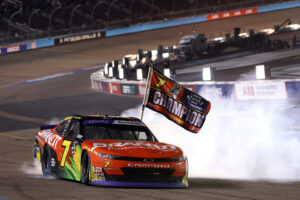BRISTOL, Tenn. — Track workers crept along the lines in the dirt left by the water truck to inspect the surface. Meanwhile, the truck drove clockwise around the track and shot a stream of water out toward the wall. On the backstretch, it dropped down a lane and repeated the process.
Some laps, it shot out the left side. Other laps, the truck shot water out the back and front.
One worker tailed it on a motorbike and gauged the surface, himself, then stopped next to the track workers on foot to check in with them.
The end result was a surface that was suited for dirt track racing; at least by the standards of a temporary dirt track, like Bristol Motor Speedway.
The dirt of Bristol
The surface

Maintaining a proper surface for a dirt track is a delicate process. Too much water, and the surface turns to mud. Too little, and you’re sending a giant cloud of dust that drains visibility.
It’s not as clear as this picture would seem. There’s so much dust in the air.#NASCAR #BristolDirtNats #ItsBristolBaby #ItsDirtBaby pic.twitter.com/pCCoLyL8KE
— Tucker White (@TuckerWhite94) March 21, 2021
This came into play, last year, during the Food City Dirt Race, when so much dust hung in the air that NASCAR went to single file restarts for the remainder of the event.
Though that’s not entirely uncommon.
“If you look at dirt racing in general,” NASCAR executive Steve O’Donnell said, “I know some of our fans and the NASCAR industry isn’t used to seeing what happened during the race with the dust buildup. It’s a very common practice, if you experience that situation, to try and go single file to alleviate some of the dust and some of the visibility issues.”
Saturday’s super late model A-main had a dust cloud form over the track.
Furthermore, dirt tends to form to the contours of the track. This gives dirt tracks “character.” Last season, this gave us holes and dips in the track.
Something to watch for next week might be these holes and dips in Turns 3 and 4.#NASCAR #BristolDirtNats #ItsBristolBaby #ItsDirtBaby pic.twitter.com/q2tupL7uSl
— Tucker White (@TuckerWhite94) March 21, 2021
“Last year, it had a little more character and it was a little rougher, considering the speeds we’re carrying,” super late model driver Chris Ferguson said.
This season, however, drivers told a different tale.
“So the track is really smooth and this evening,” open modified driver Clay Harris said. “So this whole week, the track’s been great.”
Pretty much every driver said it was some variation of smooth and well moistened.
“This thing was smooth as glass,” he said. “It’s definitely a little bit different.”
Some dimples (lack of a better word) formed into the surface, but nothing that drivers noted as having a significant impact on the racing.
Of course, a smooth as glass surface is great to race on, but it doesn’t necessarily translate to the best racing.
“Whenever the race track’s got a little bit of chop to it, it creates a little bit of character,” super late model driver Dale McDowell said. “So the racing is a little bit more exciting, so to speak. When it gets smooth, it tends to get more single line.”
This means drivers set their cars up to run either from the top or on the bottom.
The dirt of Bristol
In conclusion

NASCAR dirt racing remains a polarizing subject. Especially when it comes to running a dirt race at Bristol. Which doesn’t sit well with a certain NASCAR writer for The Athletic.
Now I also thought at the time of its announcement that it was a dumb idea, and go back-and-forth on it.
Ultimately, it’s happening and nothing indicates Bristol’s reversing course on it, soon. Especially when attendance for the spring race dropped to roughly 30,000 in 2019. At a track that was once the toughest at which to get tickets. Of course with COVID restrictions and rain, last season, we didn’t get a good gauge of attendance for the first Cup Series dirt race in over 50 years.
Regardless of how things play out, the surface is in excellent shape for it.
TOP IMAGE: Tucker White/LastWordonSports.com






